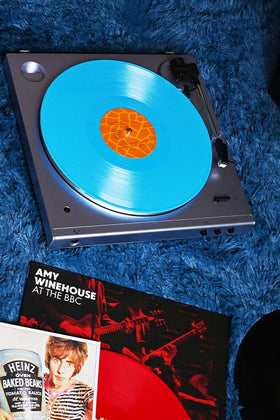Needles for Record Players: What You Should Know
If you’re aiming to get the best possible sound out of your record player, one component that you’ll definitely want to think about is your stylus, or needle. The stylus is the part of the record player that comes into direct contact with the upward-facing side of the album as it spins. That means it’s very important that your stylus is high-quality – it’s essentially the messenger that delivers the recorded music to the other components in your turntable.
In this post, we’ll walk you through the essential facts about turntable needles, plus everything you need to know to get unrivaled sound quality from your records.
What Is a Turntable Stylus?
A record player’s stylus is actually a tiny piece of unrefined diamond that is cut into a specific shape. This little piece of diamond is housed in your turntable’s cartridge. The stylus picks up specific frequencies from the grooves etched into a vinyl record, vibrating at these frequencies and transferring the vibrations to the other components in the cartridge.
We’ll talk more about the cartridge in the paragraphs to follow.
The Conical Stylus
There are two main types of record player needles – the conical stylus and the elliptical stylus. Conical styli have rounded edges, meaning they cover a larger surface area on a spinning record. While more coverage might sound like it would be better for sound quality, that’s not always the case. An untrained ear might not notice any difference between the sound produced by a conical stylus and its counterpart, the elliptical stylus, but the quality gap is definitely there.
Conical styli tend to be the standard for lower-end, entry-level turntables. These record players are usually made with cheaper parts, and they often come with a built-in amplification system and onboard speakers for convenience. However, just because a record player has a conical stylus doesn’t necessarily mean it will produce inferior sound. Quite a few Audio-Technica turntables, for example, come with a proprietary conical cartridge that sounds great.
Ultimately, conical styli are second place to their elliptical counterparts in terms of objective sound quality. However, before you decide to buy one, let’s discuss why the elliptical stylus can produce better sound.
The Elliptical Stylus
An elliptical stylus has a smaller surface area at its point, which means it’s hitting a much smaller area on a spinning record. This reduction in the surface area gives an elliptical stylus the ability to pick up a more precise range of frequencies, leading to a more accurate representation of the recording that you’re listening to.
That precision is a big deal in terms of sound quality, which makes the higher price tag on an elliptical stylus worthwhile for many audiophiles.
What About the Cartridge?
In most cases, you won’t be purchasing a conical or elliptical stylus on its own. Instead, you’ll get a cartridge, which comes equipped with a specific type of stylus. As a whole, the cartridge is one of the most important components on your turntable. Here’s everything you need to know about it.
The Parts of the Cartridge
In addition to the stylus, a cartridge contains four other main parts: the cantilever, the suspension, the coil, and the magnet. These components all work together to serve the following purposes:
All of these components in the cartridge play important roles in turning the vibrations picked up by the stylus into an electrical signal. Once that signal is amplified by your preamp, it reaches an audible volume for the first time when carried out of your speakers.
Cartridge Quality Matters
In addition to looking for a high-quality stylus, you’ll definitely want to pay attention to the other components of your cartridge as well – the cantilever, the magnet, and the coil. Here’s what you should know about these important cartridge parts.
Finding the Right Cantilever
The cantilever is a hard piece of aluminum, carbon, copper, or a similar material designed to be stiff and lightweight. Depending on how the cantilever is made and what it’s made of, you can end up with a bigger or smaller frequency range, which has a major impact on sound quality. If the cantilever is too flexible or heavy, for example, you may not get an accurate representation of what your records really sound like.
In most cases, record player cartridges come with a cantilever made from aluminum. This material is the industry standard because it’s light and carries frequencies with exceptional accuracy. Cartridges like the Audio-Technica AT91B and the Ortofon 2M Red both feature aluminum cantilevers.
If you’re investing in a high-quality cartridge, it’s highly likely that the cantilever is made from aluminum. However, just because this material is the industry standard doesn’t mean that other options are wrong. The bottom line on cantilevers is this – make sure to thoroughly research any cartridge you’re thinking about buying before you go for it. Find out what the cantilever and other components are made from and make an informed decision based on what you know.
Types of Generators
Cartridges come equipped with a generator, which usually has one of two configurations – the moving coil or the moving magnet. Moving magnet cartridges work with the help of a magnet that is directly attached to the cantilever and sends vibrations to two coils. A moving coil cartridge takes that configuration and flips it around – a single coil is attached to the cantilever and sends vibrations to a magnet. So, you’ve got the same components on both generators, just in a different order.
A moving magnet generator is the industry standard these days, and it’s also the most low-maintenance generator on the market. If you get a moving coil cartridge, you’ll need to make sure that your preamp has moving coil compatibility, which can add a significant amount of hassle to the process of building your dream audio setup.
However, while moving coil cartridges can be more of a hassle to use, they’re also some of the most sought-after pieces of turntable gear for audiophiles. These cartridges are made with extreme care and precision, and they can sound incredible.
In terms of quality, both moving coil and moving magnet generators can be excellent choices. The main issue that comes up when choosing a generator type is compatibility with the rest of your gear. Since moving coil cartridges are only compatible with certain preamps, a moving magnet cartridge tends to be the safest bet.
Cheap vs. Expensive Cartridges: What’s the Difference?
It’s important to note that the differences that you’ll hear between turntables with different types of cartridges are often very subtle. You can’t always hear a blatantly obvious quality gap between a cheap cartridge and an expensive one, and some listeners might argue that there really isn’t any difference at all. However, while it can sometimes be hard to hear the subtleties that make high-end cartridges so much better, they’re definitely real.
Here’s why investing in a high-quality cartridge can make so much of a difference in what you hear from your records.
Better Cartridges Have Better Components
When you drop several hundred dollars on a high-end phono cartridge, you’re getting what you pay for. Whether that cartridge was assembled by a machine, great care was put into making sure that it would produce the best possible sound. In addition, high-end cartridges are made with very carefully-selected components, with all of the materials used being chosen on purpose. The main quality differences that you’ll find on high-end cartridges are in the stylus, the cantilever, the coil wire, and the body of the cartridge itself.
On a well-made cartridge, all of the components work together in harmony to reduce noise, distortion, and unwanted resonance as much as possible. Every tiny piece plays a role in getting the best possible sound quality, and many audiophiles are willing to drop hundreds – or even thousands – of dollars to get the best they can get.
Conclusion
Ready to make the leap to a high-quality turntable cartridge? Make sure to check out our article highlighting the Audio-Technica AT91B, our pick for the best starter cartridge out there.
Sources:
Turntable Needles & its Functions - The Turntable Stylus guide. | Pro DJ Tips | I Love Music
How to Choose New Turntable Cartridge or Stylus | LifeWire
How Do Record Players Work? | Who invented the record player? | Live Science




